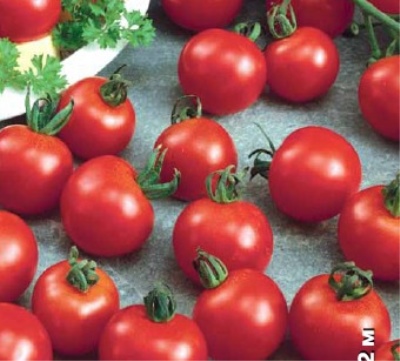
- Authors: A. N. Lukyanenko, S. V. Dubinin, I. N. Dubinina, LLC "Agrofirma Sedek"
- Year of approval: 2008
- Category: hybrid
- Growth type: indeterminate
- Appointment: fresh consumption, for whole-fruit preservation, for juice
- Ripening period: mid-early
- Ripening time, days: 95-105
- Growing conditions: for open ground, for film greenhouses
- Marketability: high
- Transportability: high
Tomato variety Children's Joy is a hybrid plant and has been listed in the State Register since 2008. The popularity of the variety among summer residents can be explained primarily by simple agricultural technology and the early ripening of fruits - you can enjoy delicious tomatoes already in the second month of summer.
Description of the variety
Tomato Children's Joy is an indeterminate variety, its features are described below.
The variety is recommended to be planted in open ground or in greenhouses.
The tomato grows up to 2 meters.
Differs in high productivity.
The main advantages of Children's joy include:
early ripening of tomatoes;
relatively high resistance to disease;
good tolerance of transportation (thanks to strong fruits with a strong skin, it retains its presentation well during transportation);
endurance to adverse weather conditions;
versatility in use (suitable for both salads and whole canning);
great fruit taste.
At the same time, this variety, like any other, has its own negative characteristics:
requires a garter;
since the variety is hybrid, there is no possibility of growing from harvested seeds.
The main qualities of the fruit
Small, strong, bright red tomatoes have the following characteristics:
small rounded fruits;
bright red color of a ripe fruit, unripe - green with a spot;
dense pulp;
weight on average 20-30 g;
firm smooth skin;
sweet and sour taste;
long shelf life (up to 2 months).
Taste characteristics
Tomatoes of the Children's Joy variety have excellent taste: a moderate combination of sour and sweetish tastes, soft, juicy pulp, make tomatoes versatile in preparation - they can be added to fresh salads, and due to their small size, they are perfect for canning. In addition, they make good sauces, juices, rolled salads, mashed potatoes and ketchup.
Ripening and fruiting
Tomato variety Children's Joy ripens quite early - as a rule, the first fruits appear in early summer, and already at the end of July you can harvest.
Tomatoes have a high level of resistance to late blight, managing to please farmers with fruits before its development, and also adapt well to any weather conditions.
Yield
The variety Children's Joy gives a good harvest: due to its resistance to weather and good immunity, about 6 kg of ripe fruits can be harvested from one square meter.
The timing of planting seedlings and planting in the ground
It is best to plant tomatoes Children's joy for seedlings: two months before transplanting to the main place, that is, in March. The seeds should be placed in prepared soil in May-June.

Growing tomato seedlings is an extremely important process, because it largely depends on whether the gardener will be able to harvest at all. All aspects must be taken into account, from seedbed preparation to planting in the ground.
Landing scheme
As you know, tomatoes of this variety are very resistant to diseases common among plants, but it is still recommended to soak the seeds in a solution of potassium permanganate in proportions of 1 g of potassium permanganate to 100 ml of water for 25-30 minutes, and then rinse with clean water.
The depth of the hole in the previously prepared soil should be no more than 2 cm; before sowing, it can also be treated with an antibacterial agent in order to avoid infection with diseases.
The optimum planting density in the ground is no more than 4 bushes per square meter. The planting scheme is 40-50 by 70 cm. After the plants are planted, it is necessary to water the beds abundantly.

Growing and care
After planting the seedlings in a permanent place, it must be watered with warm water after sunset, periodically (once every 5-7 days) it is necessary to get rid of weeds, at the same time loosening the soil under the plants - thus opening the access of oxygen to the roots.
Tomatoes Children's joy at the stage of growth and flowering require tying, and after the fruits ripen, it is recommended to fertilize them with potassium-phosphorus compounds.




A plant needs different micronutrients at each stage of growth. All fertilizers can be divided into two groups: mineral and organic. Folk remedies are often used: iodine, yeast, bird droppings, eggshells.
It is important to observe the rate and period of feeding. This also applies to folk remedies and organic fertilizers.


Review overview
Gardeners and tomato growers Children's joy note that with improper agricultural techniques and the absence of constant tying, you can lose about 25% of the crop. Judging by the reviews about the yield, an average of 1200-1500 g of juicy tomatoes can be harvested from one bush. And also the susceptibility of the variety to the disease of the top rot was noticed with improper care and excessive irrigation of plants.
A significant disadvantage is the fact that Children's Joy is a hybrid variety, so it is impossible to plant tomatoes on your own from collected seeds. Despite this disadvantage, the purchase of seeds pays off due to the unpretentiousness and productivity of the plant.
Due to the high yield and pleasant appearance of the bushes with bright fruits, tomatoes decorate both vegetable gardens and tables, so the Children's Joy variety remains one of the most popular among gardeners.

























































































